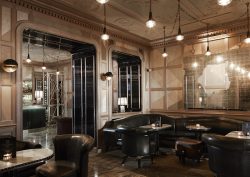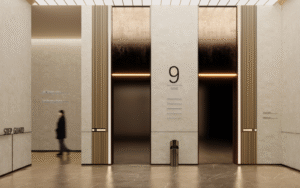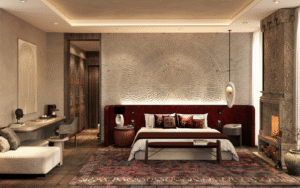The aim for Hotel Design’s latest roundtable, in association with GRAFF, was to explore bathroom design’s role within the overall hospitality experience. During Clerkenwell Design Week 2023, Editor Hamish Kilburn sat around the table at The Zetter Townhouse with seven leading designers to get the full picture on why and how bathrooms are becoming the hero in hotel design (watch the full video below)…

Clerkenwell Design Week has always been about innovative design, creative conversations and new directions; three areas that became fuel for Hotel Designs’ latest roundtable, which took place in association with GRAFF.
Mid-way through London’s highly popular design festival, Editor Hamish Kilburn offered leading interior designers seats around the table to explore the role of the bathroom within the hotel experience, and how, in fact, the perception of wellness has shifted from functional to focal point, feeding both guest and brand expectations.
The conversation started by looking back to understand how events of recent years have changed guest expectations to the point where the bathroom has in many cases become that point of differentiation – the hero, if you like – when it comes to hotel journey.
On the panel:
- Beverley Bayes, Director, Sparcstudio
- Amal Yusuf, Design Manager, David Collins Studio
- Guy Oliver, Chief Designer and MD, Oliver Laws Ltd
- Leanne Armstrong, Founder and Creative Director at Black Ivy Design
- Jane Maciver, Creative Director at Buckley Gray Yeoman
- Dawn Campbell, Managing director, Bell & Swift
- Davide Oppizi, Designer, GRAFF
Watch the full video here (and read the main takeaways below):
After introductions were made, Kilburn continued by asking what has been the most important shift or change in wellness trends – and leading on from that, bathroom design. Beverley Bayes, Director, Sparcstudio, listed a few fundamental evolutions that have found themselves on the spa-design agenda. “The most important change has been about establishing a connection to nature and linking wellness directly to the outside,” she said. “This, along with social spa-ing and a rise in health treatments that are immersive and connect with all the senses from sound rituals, to scent, to light all are impacting on the design of the hotel bathroom which is now far more immersive.”
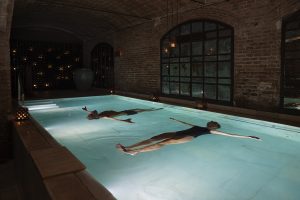
Image credit: Sparcstudio
The discussion moved on to what guests are looking for in bathroom and wellness offerings today. With the focus more broadly, from a luxury design perspective, being on paring back to allow spaces to become quietly intuitive, Kilburn asked the designers, just what makes that design difference, creating the ‘hero shot’ in a bathroom.
Leeanne Armstrong, Founder and Creative Director at Black Ivy Design responded, outlining the key points, which in the studio, sets design apart. “A good design has to be cohesive and form part of the same narrative,” she explained. “The bathroom, therefore, cannot be left out if that process. Lighting has a larger role to play in this than ever before and in fact using sensory design in the bathroom, especially, has become key. The finishes and design touchpoints all need to relate to the fabric of the building and we need to draw all these threads together to make a complete design story.”
Amal Yusuf, Design Manager, David Collins Studio, added: “It is important not to forget all the senses. Lighting is always key, but so is scent and touch – you tend to be barefoot in a bathroom, so the temperature of surfaces makes a difference,” she said. “Good design allows the use of the bathroom to become a more intuitive space.”

Image caption: The Apartment, The Connaught Hotel | Image credit: David Collins Studio
Kilburn then wanted to know if clients are more likely to take risks as a response to consumer demands for more statement design in the bathroom. Guy Oliver, Chief Designer and Managing Director, Oliver Laws, believed that storytelling in hotel design is socially fuelled. “When creating a statement that is new and unique, which takes on board touchpoints such as barefoot luxury and authenticity, it is important to work with artisans and to develop those relationships that, by their nature, add to the story of the design, as well as having a positive social impact. This is part of the broader social conversation around wellness.”
This moved the conversation on to look at how art has found its place in bathroom design. “As a space, the bathroom essentially needs to be easy to use and of course functional, but we still make sure that we inject design and layers of detail into the room,” discussed Jane Maciver, Creative Director at Buckley Gray Yeoman. “We have been bringing art and artefacts into the bathroom with bespoke pieces that are sometimes both functional and beautiful, adding layers to the space and giving it personality above and beyond its utilitarian place in the design scheme.”
Appropriately, the conversation was surrounded by the designs and finishes available from GRAFF, including its Ametis Collection, designed by Davide Oppizzi. This futuristic collection, inspired by the density of water and its colours, is one creative response to the question of immersive design and the touchpoints that contribute to the design emphasis on the bathroom. Davide Oppizi, Designer, GRAFF, went on to explain a little more. “Ametis was about thinking outside the box to design something new,” he said. “We explored the relationship between light, colour, water and wellness. We added light to the design, emphasising the play between all these elements and making the whole bathroom experience more experiential and immersive.”
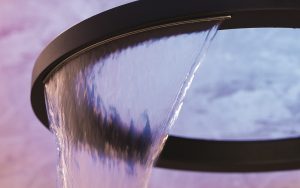
Image credit: GRAFF
This led the discussion on to the use of technology within the parameters of the bathroom. Kilburn asked the designers how this had evolved and whether or not technology has become more seamless in a bathroom. “Technology tends to now be within the appliance; it’s within the product,” responded Yusuf. “Our job is to make sure all these elements speak to each other.”
Identifying the changing demographic of luxury as a key influence in design, Kilburn asked how this was also impacting on and being interpreted in the bathroom. Dawn Campbell, Managing Director, Bell & Swift replied. “People have become a lot more intuitive about how a space makes them feel and equally they can see through it when a design lacks meaning and depth,” she mentioned. “Even working with the more commercial brands, it is important for us to make sure that everything we specify has a meaning and a purpose. All elements have to speak to each other and that includes the bathroom, as it is now far more integrated into the design as a whole”.
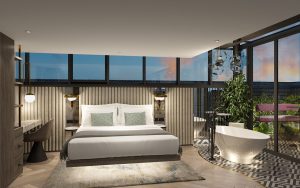
Image credit: Bell & Swift
Drawing the conversation together succinctly, Yusuf added: “We have changed the question. How will this look has become how will this feel. Everybody understands this, and it is this shift that has created the fundamental change in the direction of bathroom design and how that feeds into concepts of wellness more broadly.”
As luxury hotel brands increasingly define themselves around wellness, the bathroom has to work a lot harder as it transitions into a personal spa. To complicate the moodboard, the language of luxury is unquestionably changing, but despite that, the designers around the table delved into the pros and cons of colour in the bathroom, explored the multi-faceted face of surface design, while debating longevity versus design innovation. What emerged clearly from all of this is that the role of the bathroom has moved on.
The future of statement bathroom design lies in the hands of whoever will be bold enough to innovate beyond the boundaries of yesterday. With the demand for sensory design notes, premium products, spaces that feel intuitively tranquil – and the fact that bathrooms, by nature, require durable solutions that have longevity in the overall hotel design context – surely that calls for a little more budget allocated towards tomorrow’s bathroom experiences?
GRAFF is one of our Recommended Suppliers and regularly features in our Supplier News section of the website. If you are interested in becoming one of our Recommended Suppliers, please email Katy Phillips.
Main image credit: GRAFF








